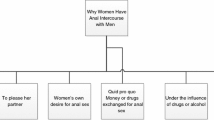Abstract
Research on sexual behavior often characterizes rough sex as sexual aggression and as violent or abusive in nature. In a sample of 734 male and female undergraduates, we examined the extent of rough sexual acts in romantic relationships, the triggers for those acts, and how rough sex differs from “typical” sex. Participants were asked their definition of rough sex, questions regarding sexual aggression and behaviors during rough sex, and abusive behaviors in the relationship. Findings indicate that rough sex is triggered by curiosity and a need for novelty, and that both men and women often initiate rough sexual behaviors. Consensual rough sex typically results in little violence and only superficial injuries such as scratches, bruises, and welts. Rough sex does not correlate with violence in the relationship or abuse. However, rough sexual behaviors were increased in situations that involved male sexual jealousy. Being separated from a sexual partner was the second most common trigger for rough sex, particularly for men. Aspects of rough sex, such as increased semen displacement and decreased latency for female orgasm are discussed.
Similar content being viewed by others
References
Burch, R. L., & Gallup Jr, G. G. (2000). Perceptions of paternal resemblance predict family violence. Evolution and Human Behavior, 21(6), 429–435.
Burch, R. L., & Gallup, G. G. (2004). Pregnancy as a stimulus for domestic violence. Journal of family violence, 19(4), 243–247.
Buzash, G. E. (1989). The rough sex defense. Journal of Criminal Law & Criminology, 80, 557.
Camilleri, J. A., & Stiver, K. A. (2014). Adaptation and sexual offending. In V. A. Weekes-Shackelford & T. K. Shackelford (Eds.), Evolutionary perspectives on human sexual psychology and behavior (pp. 43–67). NY: Springer.
Cordero, C., & Eberhard, W. G. (2003). Female choice of sexually antagonistic male adaptations: a critical review of some current research. Journal of Evolutionary Biology, 16, 1–6.
Finkelhor, D., & Yllo, K. (1982). Forced sex in marriage: a preliminary research report. Crime and Delinquency, 28, 459–478.
Gallup, G. G., Jr., & Burch, R. L. (2004). Semen displacement as a sperm competition strategy in humans. Evolutionary Psychology, 2(1), 147470490400200105.
Gallup, G. G., Jr., Burch, R. L., Zappieri, M. L., Parvez, R. A., Stockwell, M. L., & Davis, J. A., (2003). The human penis as a semen displacement devise. Evolution and human behavior, (24), 277–289.
Gallup, G., Burch, R., & Berens Mitchell, T. (2006). Semen displacement as a sperm competition strategy. Human Nature, 17(3), 253–264.
Hanna, C. (2000). Sex is not a sport: consent and violence in criminal law. BCL Rev., 42, 239.
Hazen, H. (1983). Endless rapture: rape, romance, and the female imagination. New York: Charles Scribner’s Sons.
Honkatukia, P. (2001). Rough sex? Understandings of rape in Finnish police reports. Journal Of Scandinavian Studies in Criminology and Crime Prevention, 2(1), 15–30.
Kluge, A. G. (1981). The life history, social organization, and parental behavior of Hyla rosenbergi Boulenger, a nest-building gladiator frog (Vol. 160, pp. 1–170). Miscellaneous Publications Museum of Zoology University of Michigan.
Koss, M. P., & Oros, C. J. (1982). Sexual experiences survey: a research instrument investigating sexual aggression and victimization. Journal of Consulting and Clinical Psychology, 50(3), 455–457.
Krahé, B., Berger, A., Vanwesenbeeck, I., Bianchi, G., Chliaoutakis, J., Fernández-Fuertes, A. A., Fuertes, A., de Matos, M. G., Hadjigeorgiou, E., Haller, B., & Hellemans, S. (2015). Prevalence and correlates of young people’s sexual aggression perpetration and victimisation in 10 European countries: a multi-level analysis. Culture, Health & Sexuality, 17(6), 682–699.
Lavoie, F., Robitaille, L., & Hébert, M. (2000). Teen dating relationships and aggression: an exploratory study. Violence Against Women, 6(1), 6–36.
McKee, A. (2015). Methodological issues in defining aggression for content analyses of sexually explicit material. Archives of Sexual Behavior, 44(1), 81–87.
Messing, J. T., Thaller, J., & Bagwell, M. (2014). Factors related to sexual abuse and forced sex in a sample of women experiencing police-involved intimate partner violence. Health & Social Work, 39(3), 181–191.
Pa, M. (2001). Beyond the pleasure principle: the criminalization of consensual sadomasochistic sex. Texas Journal of Women & Law, 11, 51.
Renaud, C. A., & Byers, E. S. (1999). Exploring the frequency, diversity, and content of university students’ positive and negative sexual cognitions. The Canadian Journal of Human Sexuality, 8(1), 17.
Ross, R. R., & Allgeier, E. R. (1996). Behind the pencil/paper measurement of sexual coercion: interview based clarification of men’s interpretations of sexual experiences survey items 1. Journal of Applied Social Psychology, 26(18), 1587–1616.
Ryan, K. M. (1995). Do courtship-violent men have characteristics associated with a “Battering Personality”? Journal of Family Violence, 10(1), 99–120.
Ryan, K. M. (1998). The relationship between courtship violence and sexual aggression in college students. Journal of Family Violence, 13(4), 377–394.
Ryan, K., & Mohr, S. (2005). Gender differences in playful aggression during courtship in college students. Sex Roles, 53, 591–601.
Salmon, C., & Symons, D. (2003). Warrior lovers: erotic fiction, evolution and female sexuality. Yale University Press.
Shepard, M. F., & Campbell, J. A. (1992). The abusive behavior inventory: a measure of psychological and physical abuse. Journal of Interpersonal Violence, 7(3), 291–305.
Vogels, E. A., & O’Sullivan, L. F. (2018). The relationship among online sexually explicit material exposure to, desire for, and participation in rough sex. Archives of Sexual Behavior, 1–13.
Weinberg, J. D. (2016). Consensual violence: sex, sports, and the politics of injury. University of California Press.
West-Eberhard, M. J. (2014). Darwin’s forgotten idea: the social essence of sexual selection. Neuroscience and Biobehavioral Reviews, 46, 501–508.
Author information
Authors and Affiliations
Corresponding author
Ethics declarations
All procedures performed in studies involving human participants were in accordance with the ethical standards of the institutional and/or national research committee and with the 1964 Helsinki declaration and its later amendments or comparable ethical standards.
Conflict of Interest
The authors declare that there is no conflict of interest.
Additional information
Publisher’s Note
Springer Nature remains neutral with regard to jurisdictional claims in published maps and institutional affiliations.
Appendix
Appendix
Rights and permissions
About this article
Cite this article
Burch, R.L., Salmon, C. The Rough Stuff: Understanding Aggressive Consensual Sex. Evolutionary Psychological Science 5, 383–393 (2019). https://doi.org/10.1007/s40806-019-00196-y
Published:
Issue Date:
DOI: https://doi.org/10.1007/s40806-019-00196-y




